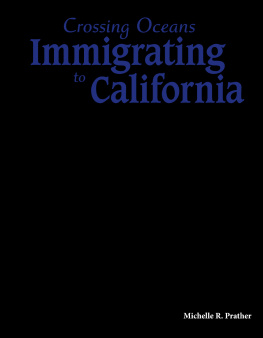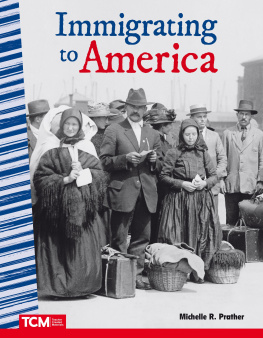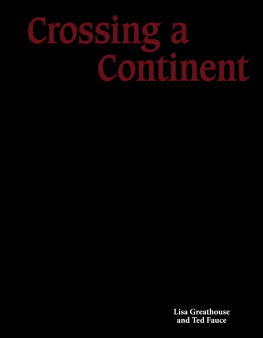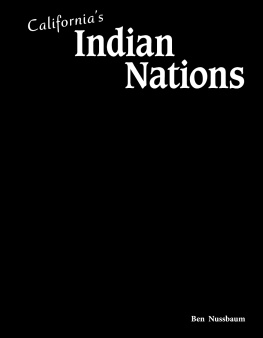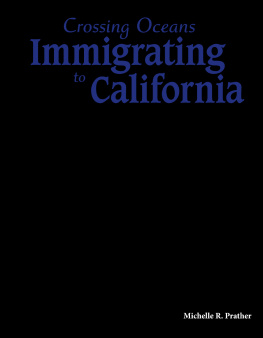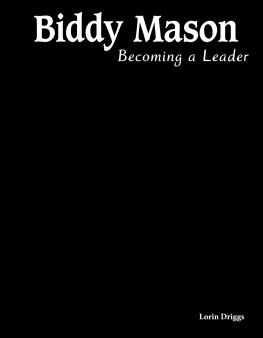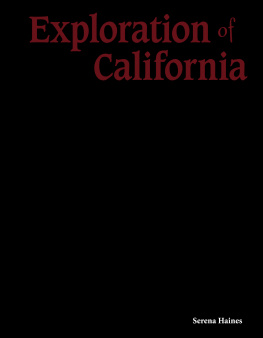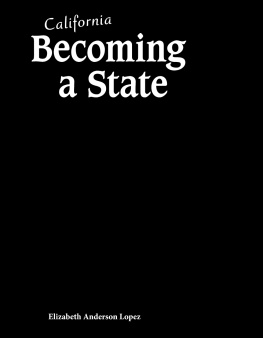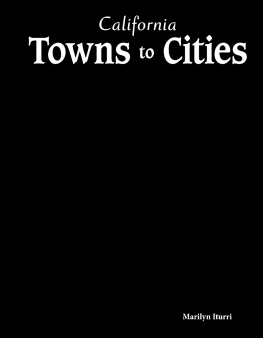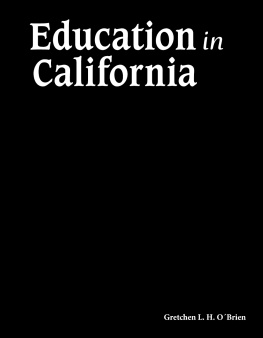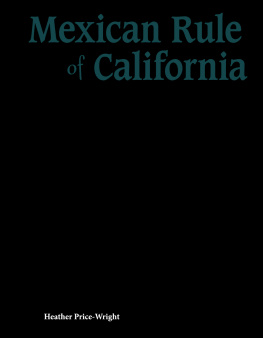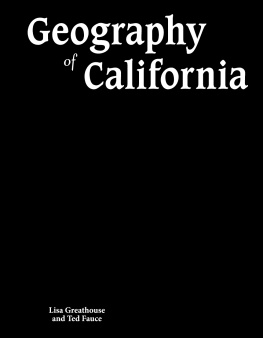Michelle R. Prather - Crossing Oceans: Immigrating to California
Here you can read online Michelle R. Prather - Crossing Oceans: Immigrating to California full text of the book (entire story) in english for free. Download pdf and epub, get meaning, cover and reviews about this ebook. year: 2018, publisher: Teacher Created Materials, genre: Politics. Description of the work, (preface) as well as reviews are available. Best literature library LitArk.com created for fans of good reading and offers a wide selection of genres:
Romance novel
Science fiction
Adventure
Detective
Science
History
Home and family
Prose
Art
Politics
Computer
Non-fiction
Religion
Business
Children
Humor
Choose a favorite category and find really read worthwhile books. Enjoy immersion in the world of imagination, feel the emotions of the characters or learn something new for yourself, make an fascinating discovery.
- Book:Crossing Oceans: Immigrating to California
- Author:
- Publisher:Teacher Created Materials
- Genre:
- Year:2018
- Rating:4 / 5
- Favourites:Add to favourites
- Your mark:
- 80
- 1
- 2
- 3
- 4
- 5
Crossing Oceans: Immigrating to California: summary, description and annotation
We offer to read an annotation, description, summary or preface (depends on what the author of the book "Crossing Oceans: Immigrating to California" wrote himself). If you haven't found the necessary information about the book — write in the comments, we will try to find it.
Crossing Oceans: Immigrating to California — read online for free the complete book (whole text) full work
Below is the text of the book, divided by pages. System saving the place of the last page read, allows you to conveniently read the book "Crossing Oceans: Immigrating to California" online for free, without having to search again every time where you left off. Put a bookmark, and you can go to the page where you finished reading at any time.
Font size:
Interval:
Bookmark:
0covercover.xhtmlCrossing Oceans Immigrating to California Michelle R. Prathercover1page0001page0001.xhtml22page0002page0002.xhtml33page0003page0003.xhtml44page0004page0004.xhtmlTable of Contents The Rush to California 4 Bound for Gam Saan 8 California Grows and Grows 14 The Golden State 26 Translate It 28 Glossary 30 Index 31 Your Turn 3255page0005page0005.xhtmlIn 1850, crowds gathered daily at the San Francisco post office for letters and newspapers. The Rush to California You're going to the place that they say is all gold, California's the name, for so I was told. Ballad from 1851 Every year, millions of people leave their homes and move to new countries or states. Some move to other countries because there is trouble in theirs. Maybe there is a war. Or maybe work is hard to find in their state. Sometimes, other places offer more freedom or hope.66page0006page0006.xhtmlGold had been discovered in Northern California in 1848. People in the United States and around the world were hopeful they would become rich. Where you came from didn't matter. This was a new and exciting idea. California began to grow fast. It needed workers. People could work in farming or on the railroad. It did not become known as "The Golden State" until 1968. But people believed it was golden long before that. What's the Difference? Immigrate means to enter a new country and live there permanently. Emigrate means to leave a country to live in a new country. Migrate means to move from one country or region to work or live in a new one. The State of Things Politicians asked for California to become a state in 1849. At this time, slavery was a hot topic. Tensions were high. It took a long time to debate what should be done. California was admitted to the Union the next year as a free state. an 1850 map of California's gold region77page0007page0007.xhtmlThe Gold Seekers People traveled far and wide to reach California. The climate was great there. And there was money to be made. But first, they had to endure the long trip. Americans from all over the country left their jobs and homes. They came from the North, the Midwest, the South, and the East. Some people went to California by ship. Others traveled by wagon. Both ways took around six months. People came from other parts of the world, too. There were few laws stopping immigrants from moving to the United States until the late 1880s. People from China, Mexico, and South America were some of the first to come to California. As the news about gold spread, Europeans made the long trip as well. Slavery in a Free State California was a free state. But, enslaved people were brought by Southerners to mine for gold. If they tried to flee, they could be sent back to the South.88page0008page0008.xhtmlThis 1849 cartoon shows what people would do to get to California.99page0009page0009.xhtmlBound for Gam Saan Gam Saan means Gold Mountain in Chinese. That is what the Chinese called California when they heard about the Gold Rush. They thought it would be as magical as the name sounded. Many Chinese people came from poor villages. They had suffered through floods and droughts. Wars with Britain and France had left China's economy unstable. They thought that going to California would help turn their luck around. Unskilled workers could make a lot of money and send it home to their families. At first, Chinese men were seen as hard workers. But things changed as more people came, and the gold supply diminished. The Chinese were no longer welcome. The Chinese seemed exotic. People did not like the way they talked or the foods they ate. A Race Apart "Their peculiar dress and pigtail marked them off from the rest of the population. Their camps at the mine were always apart from the main camps of white miners. This made it easier to turn upon them this hatred of outsiders. " from The Story of California from the Earliest Days to the Present by Henry Kittredge Norton, 19241010page0010page0010.xhtml Foreign Miners Tax A law was passed in California in 1850 to help keep foreigners out of the gold mines. It charged non?U. S. citizens $20 a month to dig for gold. The law was repealed the next year. But by then, many Chinese miners had already given up. Chinese immigrants dig for gold during the Gold Rush.1111page0011page0011.xhtmlChinese immigrants work on a railroad. Queues Ordinance San Francisco passed a law in the 1870s. It allowed prison wardens to cut inmates' hair to be one inch from the scalp. The Chinese felt that cutting their long braids, or queues, was a disgrace. This new rule served as a cruel way to mock their beliefs. Mistrust and Fear The Chinese had other work to turn to after gold was out of their reach. They spoke little English, but they were willing to work long hours for less money than other immigrants. Thousands of Chinese men worked on the railroad. They also used skills learned in China to cultivate California's farmland. And Chinese fishermen played a key role in the growth of the city of Monterey, California.1212page0012page0012.xhtmlThe Chinese also worked as servants, made clothes, and ran shops. But their hard work put them at risk. The United States was in a depression in 1873. Nativism was strong. That means Americans cared more about their own people doing well than people from other places. There were few jobs. Union leaders blamed the Chinese for that. Americans and the unions made bold claims. They said the Chinese had no morals and should be feared. Working on the Railroad The Chinese helped build the railroads in the 1860s. Leland Stanford financed the railway system. He told Congress that the Chinese were important. He said that the western part of the railroad could not be completed without them. An 1882 cartoon shows how Chinese workers were unwanted in the United States.1313page0013page0013.xhtmlStrength in Numbers By 1870, there were more than 48, 000 Chinese people in California. Some Americans saw them as threats. They wanted nothing to do with them. So the Chinese united. They built their communities. It was in these places that they could live, work, and pray. These places were called Chinatowns. The Chinatown in San Francisco is the oldest and largest in the United States. It is like its own city. In the late 1800s, Chinese children were banned from public schools. But they did not let that stop them from learning. They kept their culture alive through art, plays, and music. The cities of Oakland and Los Angeles also have Chinatowns. Shops and restaurants line their streets. Festivals and special events are held to attract people each year. Staying Connected The Chinese wanted to hold on to their beliefs. The emperor and empress of China wanted that, too. They paid to build a temple in Northern California in 1863. It's called the Oroville Chinese Temple. Chinese men in the area built the temple. the Oroville Chinese Temple today1414page0014page0014.xhtml Chinese Cuisine Over the years, shops and restaurants have opened in Chinatown. One of the oldest dim sum restaurants is the Hang Ah Tea Room, which opened in 1920. Th e term dim sum refers to a variety of bite? size foods. They are usually steamed, baked, or fried. These include dumplings and buns. In the early 1900s, a group of men gather outside shops in Chinatown, San Francisco.1515page0015page0015.xhtml Fact or Fiction A law was passed in 1850 that made foreign miners pay an extra tax. Joaqun Murieta (hwah?KEEN moo?ree?EH?tah), a miner from Mexico, moved to California from Mexico during the Gold Rush. Legend has it that Murieta and other men joined forces to fight against being taxed. It is said they robbed miners and stagecoaches of their gold. When the thefts stopped, Murieta was said to be dead. But many Mexican Americans hoped he escaped. Growth Spurt In the mid?1800s, less than 100, 000 people lived in California. Over the next few years, that number would rise. By the turn of the century, it was nearly 1. 5 million! California Grows and Grows California is one of the most ethnically diverse states. People have come from all around the world. They are from different cultures. This trend started during the Gold Rush. Many people who came to mine gold for the short term left. But others made the state their home. The idea that California was growing and that there were new ways to make money lured even more people.1616page0016page0016.xhtmlOver 2, 000 men came from Sonora, Mexico. This was around the same time as the Chinese immigrants. These miners often traveled with their whole families. They were also treated with scorn when gold grew scarce. They built a camp in central California. The camp became known as Sonora. It was named for the place they left behind. People from Peru, China, Australia, and France stayed there during the Gold Rush, too. It is one of the oldest cities in the state. Sonora, California, in 1866 Sonora, California, in 18531717page0017page0017.xhtmlValley View in Yosemite National Park Muir's Land John Muir immigrated to America from Scotland as a boy. He visited Yosemite, which is located near San Francisco, in 1868. He loved its natural beauty. The next year, he moved there. The many things he wrote about the area helped it become a national park in 1890. Diverse San Francisco San Francisco was the New York City of the West. Many immigrants made it their home after the Gold Rush. At first, the city was known as Yerba Buena. Local leaders changed the city's name in 1847. The new name matched the nearby bay and mission. After the Gold Rush, trade with other countries was on the rise. The city's new name was about to go global. By 1860, half of the people in the city were immigrants. They came from many countries in Europe. There were also people who came from China, Japan, and Mexico.1818page0018page0018.xhtmlImmigrants changed where they lived. They wanted to be around things that reminded them of home. That's why many immigrants from the same areas settled near each other. They started businesses. They made San Francisco a unique place. They made it the multicultural hub it is today. Cable Cars San Francisco's first cable car line opened in 1873. Andrew Hallidie (HAH-lih-dee) from Scotland came up with the idea. He saw horses being whipped as they tried to pull a horse car up a wet street. He invented a better way that is still used. By 1860, San Francisco was a busy city.1919page0019page0019.xhtmlAn 1874 advertisement shows a farmer wearing the new blue jeans patented by Strauss and Davis. Inventive Immigrants During the Gold Rush, thousands of immigrants moved to San Francisco. Among them were two unique men. These men wanted to sell products to miners and people in the city. They both found new ways to make their products. Their companies are successful even today. And their products are still sold around the world. Levi Strauss was born in Germany. He first lived in New York before moving to San Francisco in 1853. There, he began a business that sold tents, clothes, and other goods. The company was later called Levi Strauss & Co. Strauss partnered with Jacob Davis on a new type of pants. Davis had come up with a way to make pants using rivets. In 1873, the two men got a patent, and blue jeans were made!2020page0020page0020.xhtmlDomingo Ghirardelli (GEER-ahr-deh-lee) was born in Italy. After hearing about the Gold Rush, he sailed to California. He set up a store in a tent and sold supplies and sweets to miners. Three years later, he opened his first candy store in San Francisco. His store did well. In 1867, a worker at his store found a new way to make chocolate. This process is now used by many candy makers. If at First You Don't Succeed Ghirardelli lost his first stores in two separate fires. He gathered what he had left and opened the Cairo Coffee Shop in San Francisco. The shop did not succeed. It was at this point that he opened his candy store in the city. From 1852 to 1895, it moved four times. Today, it stands in Ghirardelli Square.2121page0021page0021.xhtmlGrowth of Los Angeles After statehood, people started looking at what the southern part of the state had to offer. In the 1850s, a group of Germans left San Francisco. They bought land southeast of Los Angeles. There, they produced wine. The name of their colony was Anaheim. The name was based on two things : Ana was for the Santa Ana River, and heim means "home" in German. This was the beginning of a shift. Then, thousands of immigrants moved to Los Angeles. They came from China and Mexico. People also came from other countries in Europe. Many Americans migrated there, too. This included African Americans after the Civil War. One of the keys to the growth of the area was the completion of a railroad in 1876. It connected San Francisco and Los Angeles. Trains made it easier to reach Los Angeles from other states. And the region was being touted as a great place to live. The New Minority Before 1850, Los Angeles was not as diverse as it is today. There were more Mexicans than any other group at that time. As the city's economy grew, things changed. More white settlers moved there. Mexicans became one of the smallest groups.2222page0022page0022.xhtmlMen work at a citrus grove. Fruitful State The first navel orange trees in the state were planted in 1873. Within a few years, oranges were in high demand. Thanks to the railroad, the whole country could have them. The state became known for its sunny weather and healthy crops. Los Angeles in the late 1800s2323page0023page0023.xhtmlBusiness Boom When immigrants moved to the state in large numbers, the demand for goods and services rose. This caused economic growth in the state. During the Gold Rush, people needed basic things. They needed dry goods and tools for mining. And people needed food and places to stay. The Transcontinental Railroad was finished in 1869. People and goods moved from place to place faster. Towns began to thrive. Industry surged. Agriculture became a huge part of the state's economy. The railroads also brought tourists to the state. Once they saw its beauty, many visitors wanted to stay. That made the real estate market grow. Oil also became big business. Oil was found in Northern California in 1865. About 30 years later, oil was found in Southern California. And there was a lot of it. People made millions of dollars. a passenger train from the late 1800s2424page0024page0024.xhtml Doheny Oil The millionaire oil mogul Edward L. Doheny had humble roots. Doheny was very poor. He tried to make money in all kinds of ways even as a gold miner. That didn't pan out, but striking oil in Los Angeles did. oil field in Southern California2525page0025page0025.xhtmlGoverning California California was a brand new state when it found itself on the brink of great change. Its landscape changed as cities were built. The railroad connected it with the rest of the nation. More immigrants came to settle. These changes helped develop the new state's economy and government. But they sometimes led to unrest and conflict. In 1851, San Francisco was a violent place. Crime was high. It was too much for officials to deal with. People took the law into their own hands. They arrested people they thought broke the law. They even deported immigrants found guilty of crimes. In 1879, California passed a new state constitution. Part of the new law banned Chinese workers. People could not hire them. This was a difficult time for immigrants in California. Denis Kearney Denis Kearney led the Workingmen's Party in the state in the late 1870s. He wanted to make Chinese immigrants leave. He said they took jobs away from Americans. Many people did not agree with him. They reminded Kearney that he was from Ireland.2626page0026page0026.xhtmlThis cartoon shows the United States forcing out the Chinese immigrants. Anti-Chinese Laws In 1882, the U.S. government banned Chinese workers from entering the country. It was the first time the United States banned a group of people based on their ethnicity.2727page0027page0027.xhtmldowntown Los Angeles today The Golden State California isn't growing at the same pace as it has in the past. But people still go there to "live the dream. " And many of them still come from all over the world. After all, the state grew because of immigrants who took chances in a new land. Because of this, the state remains a place where you can be who you want to be. The glimmer of hope lies more in the state's big industries than gold these days. People come to the state to make it big as tech experts or entrepreneurs. Many people want to work in Hollywood or the service industry. And plenty find work in aerospace and agriculture. In the great state of California, there is bound to be something for everyone.2828page0028page0028.xhtml Slowing Down At the end of 2015, there were about 39 million people in the state. It was the eleventh year in a row that the number of people had grown by less than 1 percent. Not as many people are moving to the state. And there are fewer babies being born there than before. Immigration by the Numbers California has more immigrants than any other state, with over 10 million. It's one of the four states in which the minority population makes up the majority. Over half of the state's population is Latino. But in recent years, more people have been emigrating from Asia.2929page0029page0029.xhtmlTranslate It! It was common for immigrants from the same countries to live together in neighborhoods. That way, they supported each other. They could be themselves. They could speak their own languages without fear. Chinese people did this by building Chinatowns. They could go to Chinese shops, find places to live, and seek services from those they trusted. But things were different when they first arrived in California. They had to get what they needed using what little English they knew. Imagine trying to complete even the simplest task if you couldn't speak or read the language. Better yet, give it a try! These three signs are ads for everyday things people need. But they're written using Chinese characters. Can you figure out what they're for?3030page0030page0030.xhtml3131page0031page0031.xhtmlGlossary aerospace the industry that deals with aviation and space flight climate the usual weather conditions a place gets colony a place where a group of people from similar backgrounds live together communities groups of people who live in the same areas cultivate to prepare land for growing crops culture the beliefs and ways of a group of people demand the desires of people who buy things deported forced someone who was not a citizen to leave a country depression a period of time when many people do not have jobs and there is little money economic relating to the buying and selling of goods and services endure to continue to exist in the same way entrepreneurs people who start and run businesses ethnically relating to groups of people that have common cultural ties exotic very unusual; having traits related to a land far away hub the center and most active part of a place immigrants people who come to a country to live there industry a group of businesses that work together to provide a particular product or service morals values that deal with what is right and wrong in human behavior multicultural having many different cultural or ethnic groups represented patent a document that gives a person or company the right to be the only one that makes or sells a certain product repealed thrown out; canceled rivets metal bolts that hold two pieces of material together scorn a strong feeling of dislike shift a slight change touted made a big deal of unstable not solid; likely to change, give way, or fail3232page0032page0032.xhtmlIndex African Americans, Anaheim, China, Chinatown (s), Chinese, Civil War, Doheny, Edward L., economy, Europe, Foreign Miners Tax, France, Germany, Ghirardelli, Domingo Golden State, Gold Mountain, Gold Rush, Hallidie, Andrew, Hollywood, Kearney, Denis, Los Angeles, Mexico, Monterey, Muir, John, Murieta, Joaqun, Northern California, Oroville Chinese Temple, Queues Ordinance, railroad, San Francisco, Scotland, Sonora, South America, Southern California, Strauss, Levi, Transcontinental Railroad, Workingmen's Party, Yerba Buena,3333page0033page0033.xhtmlYour Turn! Political Cartoons Political cartoons express ideas. In the 1850s, Chinese immigrants faced discrimination in the United States. This cartoon, titled "The Only One Barred Out, " captures that idea. Carefully examine the elements in the cartoon. What does the "Golden Gate of Liberty" represent? The Chinese were known for many positive traits when they came to California. How are those traits shown? Analyze the list of people who were welcomed at the time. Why is this list important? How is the cartoon's title appropriate? Write a paragraph to explain your opinion.3434page0034page0034.xhtmlRead and Respond 1. What are some problems a community faces when it grows very quickly? 2. Why did so many people want to move to California, even after the Gold Rush? 3. How did people from around the world change everyday life in California? 4. How might the construction of the Transcontinental Railroad have been different if the Chinese immigrants didn't help? 5. Imagine you lived in New York City around 1870. What are some reasons you might be tempted to move to California? 6. Write a journal entry as a Chinese immigrant. Describe a typical day as a miner or a railroad worker.3535page0035page0035.xhtmlCrossing Oceans Immigrating to California California is a big state with an even bigger story. It grew by leaps and bounds between the Gold Rush and 1900. People from around the world moved there because it was full of opportunity. It was a place where people from all different backgrounds came to live their dreams. A Changing California36
Next pageFont size:
Interval:
Bookmark:
Similar books «Crossing Oceans: Immigrating to California»
Look at similar books to Crossing Oceans: Immigrating to California. We have selected literature similar in name and meaning in the hope of providing readers with more options to find new, interesting, not yet read works.
Discussion, reviews of the book Crossing Oceans: Immigrating to California and just readers' own opinions. Leave your comments, write what you think about the work, its meaning or the main characters. Specify what exactly you liked and what you didn't like, and why you think so.

